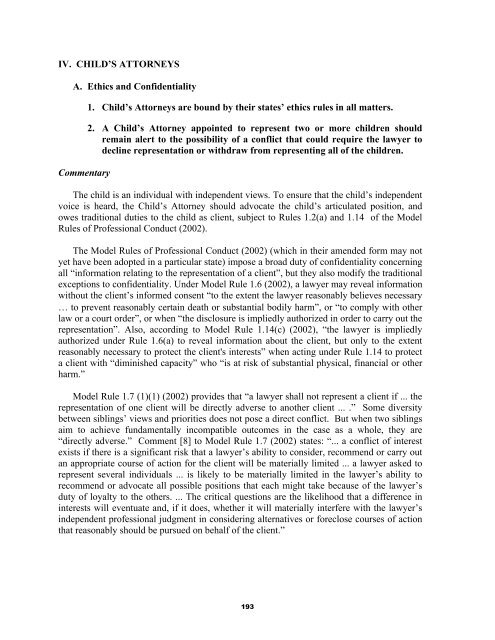A Judge’s Guide
A Judge’s Guide
A Judge’s Guide
Create successful ePaper yourself
Turn your PDF publications into a flip-book with our unique Google optimized e-Paper software.
IV. CHILD’S ATTORNEYS<br />
A. Ethics and Confidentiality<br />
Commentary<br />
1. Child’s Attorneys are bound by their states’ ethics rules in all matters.<br />
2. A Child’s Attorney appointed to represent two or more children should<br />
remain alert to the possibility of a conflict that could require the lawyer to<br />
decline representation or withdraw from representing all of the children.<br />
The child is an individual with independent views. To ensure that the child’s independent<br />
voice is heard, the Child’s Attorney should advocate the child’s articulated position, and<br />
owes traditional duties to the child as client, subject to Rules 1.2(a) and 1.14 of the Model<br />
Rules of Professional Conduct (2002).<br />
The Model Rules of Professional Conduct (2002) (which in their amended form may not<br />
yet have been adopted in a particular state) impose a broad duty of confidentiality concerning<br />
all “information relating to the representation of a client”, but they also modify the traditional<br />
exceptions to confidentiality. Under Model Rule 1.6 (2002), a lawyer may reveal information<br />
without the client’s informed consent “to the extent the lawyer reasonably believes necessary<br />
to prevent reasonably certain death or substantial bodily harm”, or “to comply with other<br />
law or a court order”, or when “the disclosure is impliedly authorized in order to carry out the<br />
representation”. Also, according to Model Rule 1.14(c) (2002), “the lawyer is impliedly<br />
authorized under Rule 1.6(a) to reveal information about the client, but only to the extent<br />
reasonably necessary to protect the client's interests” when acting under Rule 1.14 to protect<br />
a client with “diminished capacity” who “is at risk of substantial physical, financial or other<br />
harm.”<br />
Model Rule 1.7 (1)(1) (2002) provides that “a lawyer shall not represent a client if ... the<br />
representation of one client will be directly adverse to another client ... .” Some diversity<br />
between siblings’ views and priorities does not pose a direct conflict. But when two siblings<br />
aim to achieve fundamentally incompatible outcomes in the case as a whole, they are<br />
“directly adverse.” Comment [8] to Model Rule 1.7 (2002) states: “... a conflict of interest<br />
exists if there is a significant risk that a lawyer’s ability to consider, recommend or carry out<br />
an appropriate course of action for the client will be materially limited ... a lawyer asked to<br />
represent several individuals ... is likely to be materially limited in the lawyer’s ability to<br />
recommend or advocate all possible positions that each might take because of the lawyer’s<br />
duty of loyalty to the others. ... The critical questions are the likelihood that a difference in<br />
interests will eventuate and, if it does, whether it will materially interfere with the lawyer’s<br />
independent professional judgment in considering alternatives or foreclose courses of action<br />
that reasonably should be pursued on behalf of the client.”<br />
193


